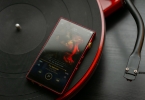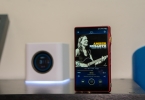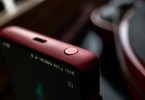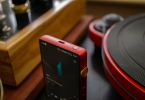iBasso DX160 Digital Audio Player Review

Matthew Jens samples the latest version of this popular mid-priced music portable…
iBasso
DX160 Digital Audio Player
AUD $649 RRP

The original iPod was a pivotal moment in portable audio. First, we had Sony's original cassette Walkman of 1979, then portable CD players appeared in the late eighties, and subsequently, MiniDisc followed shortly after. Apple arrived with its iPod just a couple of years into the new millennium, redefining mobile music yet again. This changed things forever…
That's all water under the bridge. Smartphones have now all but killed off the headphone jack, leaving people like you and me in a fascinating predicament. We can no longer rely on our smartphones to drive our wired headphones unless we want to carry bulky DACs or a dongle for the ride. So for this very reason, many audiophiles are now turning to Digital Audio Players (or DAPs) instead.
There have generally always been two sectors in the DAP world; the low end (with products such as the FiiO M5) and the high end (where you'll find the Astell&Kern A&Norma line). But a new midrange division of the DAP market has been growing exponentially, and it is carving a niche into the market. This reasonable but functional department is where you'll find the FiiO X11, the Cowon Plenue R, and this little guy – the 2020 version of iBasso's DX160. We now have a growing market tier, with some fierce competitors racing to be the top dog within it. Our first look into this is a midrange audio player at a mid-range price, but does it also mean it will be merely adequate in other areas as well? Let's find out…

UP CLOSE
The DX160 was released in 2019, with a screen that came from Sharp. However, the supply of these screens dried up, so a lesser quality display from JDI replaced it. iBasso felt that the new JDI display was inferior, so bumped up some of the internal audio specs and called it the 2020 version. It's safe to say the owners of the original 2019 version were not too happy about this change and voiced their dissent in droves online.
On the outside, the DX160 can do no wrong. With sleek premium offerings from giants such as Astell&Kern, Sony and Apple poking around, it's a market that demands that any competitor must look and feel attractive. We, as consumers, reap the rewards. Even as a mid-market device, this thing feels slick – the 178g weight gives it just the right amount of heft, and it's easy to carry around at 113x70x150mm. My particular review model is red, which has a matte finish around the outside, and a glossy finish on the back. The gold volume knob is stepped and feels firm without being too tight. The buttons have very little travel and need little pressure to register a press.

Let's talk about that screen as well. It's hard to miss, as it extends to the edges except for a tiny chin on the bottom. In the smartphone world, this is expected. In the DAP world, however, this is exceptional and fantastic. The display is vibrant, clean and crisp, which is more than enough for what it needs to be to display album art.
As far as connectivity goes, we have USB type C on charging and data duties, a 4.4mm port for balanced output, and a single 3.5mm port to handle standard headphone output, S/PDIF and line out. Inside, we're looking at a 3200mAh battery and a Rockchip based SoC. iBasso was rather sheepish about admitting which SoC was inside the DX160, and it took quite a bit of coaxing from the online community to get them to admit it. Many believe this reluctance is because this processor is generally seen as being slow and cheap, rendering the DX160 to be quite low on general processing power.
What this little guy lacks in processing power, it makes up for in spades with serious audio hardware. With dual Cirrus Logic CS43198 DAC chips, LDAC codec support, DSD and MQA compatibility as well as a clear output path, the DX160 clearly has a flagship-worthy list of audio credentials. All of that audio prowess can be either fed by files stored on an SD card (or the measly 32GB onboard storage, of which 28 is usable) or by any app you please. For tricky political reasons, iBasso can't ship the unit with the default Android Play Store. Still, you can easily install this with third party firmware, which iBasso has confirmed, won't ruin your warranty situation.

Despite the meagre horsepower under the hood, all the usual suspects (Spotify, Tidal, Poweramp) all run flawlessly on this unit, even when it's playing full-size DSD files. I suspect the software has been fine-tuned for the hardware available to it. It can be made even better with third party firmware hacks, which are a little tricky to install but are very rewarding to use. And when you would prefer to put the dual DACs of the DX160 to work with another source, you can set the device in DAC mode, plug it into your USB source and listen away. You have the option of using Bluetooth as well but just be warned that there is an audible delay when doing so.
Battery life is tolerable, ranging from nine to twelve hours, and charging to full in just one and a half. It may not sound like a lot, but it's light years ahead of the measly few hours you'll get from Sony's newest offerings (such as the A55, which will only fetch a handful of hours of playback time).

SOUND QUALITY
The DX160 boasts system-wide audio options, such as four different digital filters and two different gain settings. Individual apps can control EQ - the included Mango player is the stock standard iBasso player. Still, I prefer the expanded functionality and sound options from apps such as PowerAmp.
Its small form factor may lead you to believe that the DX160 pairs well with IEMs, and you would be correct in assuming so. Even with fussy, low impedance hybrid IEMs (such as the 5-driver Unique Melody Merlin) the low output impedance of the DX160 ensures that frequency response is kept clean and natural. There is also a decent amount of finite volume control with plenty of steps. Small audible adjustments are easy to make without the risk having volume spikes that blow your head off.

Stepping up to something slightly more challenging, the DX160 was quite complacent when driving the 32 ohms Denon D5000, and 23 ohm Sennheiser HD630VB headphones. Throughout the entire listen, the DX160 maintained its composure and never broke a sweat. Even on the low-gain mode, it squeezed out more than enough juice to drive these cans with confidence.
It wasn't all good news, however. Pairing a simple pair of Bluetooth headphones provided a frustrating amount of connection hiccups, even at close range. It wasn't a clean connection, regardless of what headphones I used. Even the powerful Bluetooth ability of the Bowers & Wilkins PX7 headphones wasn't strong enough to maintain a healthy connection. It wasn't a complete disaster; things would work well for several tracks at a time, but then there would be slight glitching and skipping. I would accept this from a budget player, but for a mid-range device, this doesn't fly.

However, a redeeming quality was when I lay down the final challenge: The demanding and fussy Sennheiser HD800S. Putting the player in high-gain mode and donning a full-size to 3.5mm adapter, the DX160 happily pumped plenty of body into the thirsty Teutonic drivers. It didn't drive them with quite the same authority as my desktop gear. Still, it left me wondering just how accurately I would be able to tell the two apart in a blind test – and that's a powerful compliment to the DX160.
Considering the similar price points, I know a lot of people are keen to hear how this unit compares to the Chord Electronics MOJO. Fundamentally, I have to point out that these devices are very, very different. One has a full operating system, expandable storage, a display and a vast plethora of settings and tweaks. The other is a precision designed, FGPA based DAC. Audibly they don't sound worlds apart – which is a testament to the strengths of the DX160 – but the MOJO can drive larger and heavier loads with more authority, detail and control. The DX160 also stands alone on its own two feet of course, whereas the MOJO needs something to drive it.

THE VERDICT
The latest 2020 version of iBasso's DX160 proves that you don't need to spend thousands on a DAP – it looks and feels fantastic, sounds sublime (especially at the price), and with a little bit of know-how and elbow grease, you can customise it to be your very own. Yes, the processor lets it down a little, and the Bluetooth isn't blameless – but what counts is the sound, and no excuses are needed for that. Well worth a look then, if you're into affordable music on the move.
Click here to find your nearest dealer
Matthew Jens
Constantly keeping himself busy, Matthew is a production manager, Brazilian jiu-jitsu blue belt, Head-Fi fanatic, coffee enthusiast and all-round cool Dad.
Posted in:Hi-Fi Headphones Sources Digital Audio Players
Tags: ibasso minidisc
JOIN IN THE DISCUSSION
Want to share your opinion or get advice from other enthusiasts? Then head into the Message Forums where thousands of other enthusiasts are communicating on a daily basis.
CLICK HERE FOR FREE MEMBERSHIP
Trending
applause awards
Each time StereoNET reviews a product, it is considered for an Applause Award. Winning one marks it out as a design of great quality and distinction – a special product in its class, on the grounds of either performance, value for money, or usually both.
Applause Awards are personally issued by StereoNET’s global Editor-in-Chief, David Price – who has over three decades of experience reviewing hi-fi products at the highest level – after consulting with our senior editorial team. They are not automatically given with all reviews, nor can manufacturers purchase them.
The StereoNET editorial team includes some of the world’s most experienced and respected hi-fi journalists with a vast wealth of knowledge. Some have edited popular English language hi-fi magazines, and others have been senior contributors to famous audio journals stretching back to the late 1970s. And we also employ professional IT and home theatre specialists who work at the cutting edge of today’s technology.
We believe that no other online hi-fi and home cinema resource offers such expert knowledge, so when StereoNET gives an Applause Award, it is a trustworthy hallmark of quality. Receiving such an award is the prerequisite to becoming eligible for our annual Product of the Year awards, awarded only to the finest designs in their respective categories. Buyers of hi-fi, home cinema, and headphones can be sure that a StereoNET Applause Award winner is worthy of your most serious attention.
















